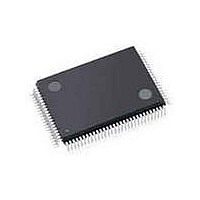C8051F040-TB Silicon Laboratories Inc, C8051F040-TB Datasheet - Page 271

C8051F040-TB
Manufacturer Part Number
C8051F040-TB
Description
BOARD PROTOTYPING W/C8051F040
Manufacturer
Silicon Laboratories Inc
Type
MCUr
Specifications of C8051F040-TB
Contents
Board
Processor To Be Evaluated
C8051F04x
Interface Type
USB
Lead Free Status / RoHS Status
Contains lead / RoHS non-compliant
For Use With/related Products
C8051F040
Lead Free Status / Rohs Status
Lead free / RoHS Compliant
- Current page: 271 of 328
- Download datasheet (3Mb)
Broadcast Address = 00111111
21.3. Configuration of a Masked Address
The UART0 address is configured via two SFRs: SADDR0 (Serial Address) and SADEN0 (Serial Address
Enable). SADEN0 sets the bit mask for the address held in SADDR0: bits set to logic 1 in SADEN0 corre-
spond to bits in SADDR0 that are checked against the received address byte; bits set to logic 0 in SADEN0
correspond to “don’t care” bits in SADDR0.
Setting the SM20 bit (SCON0.5) configures UART0 such that when a stop bit is received, UART0 will gen-
erate an interrupt only if the ninth bit is logic 1 (RB80 = ‘1’) and the received data byte matches the UART0
slave address. Following the received address interrupt, the slave will clear its SM20 bit to enable inter-
rupts on the reception of the following data byte(s). Once the entire message is received, the addressed
slave resets its SM20 bit to ignore all transmissions until it receives the next address byte. While SM20 is
logic 1, UART0 ignores all bytes that do not match the UART0 address and include a ninth bit that is logic
1.
21.4. Broadcast Addressing
Multiple addresses can be assigned to a single slave and/or a single address can be assigned to multiple
slaves, thereby enabling "broadcast" transmissions to more than one slave simultaneously. The broadcast
address is the logical OR of registers SADDR0 and SADEN0, and ‘0’s of the result are treated as “don’t
cares”. Typically a broadcast address of 0xFF (hexadecimal) is acknowledged by all slaves, assuming
“don’t care” bits as ‘1’s. The master processor can be configured to receive all transmissions or a protocol
can be implemented such that the master/slave role is temporarily reversed to enable half-duplex trans-
mission between the original master and slave(s).
Note in the above examples 4, 5, and 6, each slave would recognize as “valid” an address of 0xFF as a
broadcast address. Also note that examples 4, 5, and 6 uses the same SADDR0 and SADEN0 register
values as shown in the examples 1, 2, and 3 respectively (slaves #1, 2, and 3). Thus, a master could
address each slave device individually using a masked address, and also broadcast to all three slave
devices. For example, if a Master were to send an address “11110101”, only slave #1 would recognize the
address as valid. If a master were to then send an address of “11111111”, all three slave devices would rec-
ognize the address as a valid broadcast address.
UART0 Address = xxxx0101
Example 1, SLAVE #1
SADDR0
SADEN0
Example 4, SLAVE #1
SADDR0
SADEN0
= 00110101
= 00001111
= 00110101
= 00001111
Where all ZEROES in the Broadcast address are don’t cares.
Broadcast Address = 11110111
UART0 Address = 0011xx01
Example 2, SLAVE #2
SADDR0
SADEN0
SADDR0
SADEN0
Example 5, SLAVE #2
Rev. 1.5
C8051F040/1/2/3/4/5/6/7
00110101
11110011
= 00110101
= 11110011
=
=
Broadcast Address = 11110101
UART0 Address = 00xxxxxx
Example 3, SLAVE #3
SADDR0
SADEN0
Example 6, SLAVE #3
SADDR0
SADEN0
= 00110101
= 11000000
= 00110101
= 11000000
271
Related parts for C8051F040-TB
Image
Part Number
Description
Manufacturer
Datasheet
Request
R
Part Number:
Description:
SMD/C°/SINGLE-ENDED OUTPUT SILICON OSCILLATOR
Manufacturer:
Silicon Laboratories Inc
Part Number:
Description:
Manufacturer:
Silicon Laboratories Inc
Datasheet:
Part Number:
Description:
N/A N/A/SI4010 AES KEYFOB DEMO WITH LCD RX
Manufacturer:
Silicon Laboratories Inc
Datasheet:
Part Number:
Description:
N/A N/A/SI4010 SIMPLIFIED KEY FOB DEMO WITH LED RX
Manufacturer:
Silicon Laboratories Inc
Datasheet:
Part Number:
Description:
N/A/-40 TO 85 OC/EZLINK MODULE; F930/4432 HIGH BAND (REV E/B1)
Manufacturer:
Silicon Laboratories Inc
Part Number:
Description:
EZLink Module; F930/4432 Low Band (rev e/B1)
Manufacturer:
Silicon Laboratories Inc
Part Number:
Description:
I°/4460 10 DBM RADIO TEST CARD 434 MHZ
Manufacturer:
Silicon Laboratories Inc
Part Number:
Description:
I°/4461 14 DBM RADIO TEST CARD 868 MHZ
Manufacturer:
Silicon Laboratories Inc
Part Number:
Description:
I°/4463 20 DBM RFSWITCH RADIO TEST CARD 460 MHZ
Manufacturer:
Silicon Laboratories Inc
Part Number:
Description:
I°/4463 20 DBM RADIO TEST CARD 868 MHZ
Manufacturer:
Silicon Laboratories Inc
Part Number:
Description:
I°/4463 27 DBM RADIO TEST CARD 868 MHZ
Manufacturer:
Silicon Laboratories Inc
Part Number:
Description:
I°/4463 SKYWORKS 30 DBM RADIO TEST CARD 915 MHZ
Manufacturer:
Silicon Laboratories Inc
Part Number:
Description:
N/A N/A/-40 TO 85 OC/4463 RFMD 30 DBM RADIO TEST CARD 915 MHZ
Manufacturer:
Silicon Laboratories Inc
Part Number:
Description:
I°/4463 20 DBM RADIO TEST CARD 169 MHZ
Manufacturer:
Silicon Laboratories Inc










